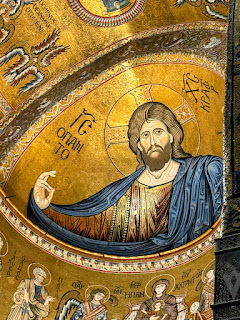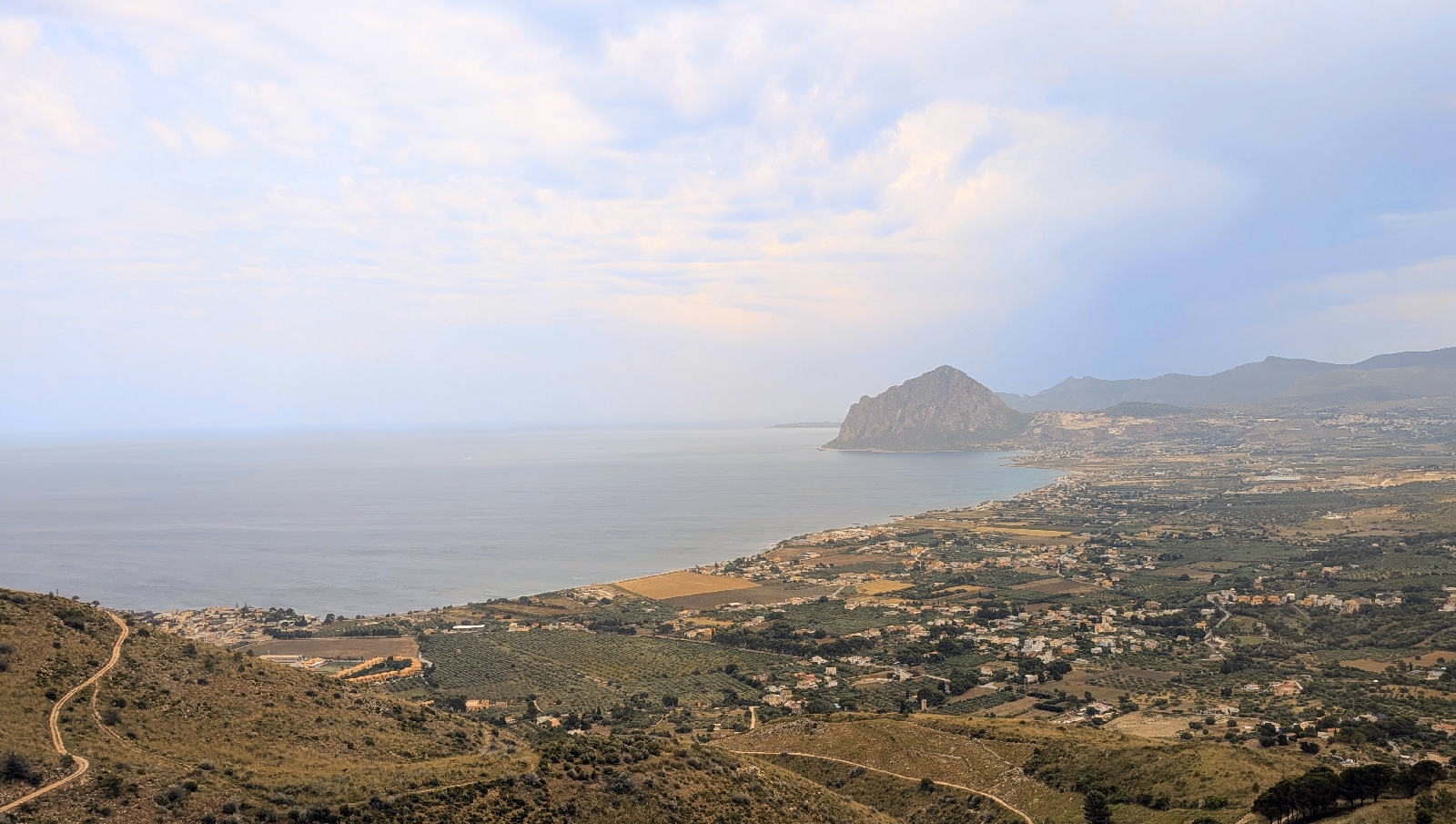
On Sunday May 18, we met our Rick Steves group mid afternoon, along with our guide Andrea (pictured above). I’m looking forward to having him as our guide because he was born and raised just outside Palermo. I’m sure he will have a ton of knowledge.
After meeting everyone, we all took a walking tour around the neighborhood to get our bearings, learn the history and see unique things. You can see Christine and I are fresh and ready to tour!
On the way to our first stop, we saw a fountain nicknamed “the fountain of shame”. Legends say it got that name because in the building in the background with the dome lived the monks, and a dome, not pictured, but in direct line of sight of the fountain and the monks dome, was the convent. Of course, the statues are naked…thus the nickname.
We also saw a peaceful Pro Palestine parade march past us. Our guide told us Sicily is fearful of war, since they have been occupied and in a war many times.
And if you look above the store fronts in the picture below, it looks like unkept buildings, but it is still the ruins of the allied bombing raids in WWII. Approximately 45% of the city was destroyed.
Next, we entered this unassuming building and we began our Sicilian adventure by joining a contessa for a tour of her family home/palace, the Palazzo Frederico.

I’ll throw in a little bit of history here: In 1861, Italy was established. As a country it is younger than the US. While Sicily is part of Italy, it is also an independent state. The first evidence of humans in Sicily are Paleolithic carvings that are from 12,000BC. While Phoenicians, Romans, Germanic tribes, Vandals and others conquered Sicily over the centuries, their first king wasn’t until 1130AD. Because we were learning about the very complicated Sicilian history, we got to meet a Sicilian aristocrat in her home in Palermo. The palace has been home to generation upon generation of Count Federico's family, which can be traced back to Holy Roman Emperor Frederick II. This is the only line of that family left.

The Countess Alwine Federico, welcomes us into her home, Palazzo Conte Federico — one of the oldest dwellings in Palermo, Sicily. She was a charismatic and welcoming person and has spent the last many years restoring her home.


She had this chair restored for her blue room not realizing that originally it was used in a brothel. Musette, her kitty seemed to like it!

When we headed up the steps to see her tower, I made this friend. Originally Palermo had Arab/Norman towers. 40 of them surrounded and protected the city along the city walls. The only one left in town is this one that we are pictured standing in. It was right in the middle of her home/palace and is approximately 800 to 1000 years old.

The picture below is from right outside of the tower and is directly below the stone window pictured above. I am showing this because they are always finding something new. Just a few years ago, they were checking if the floor boards were safe and when they pulled them up to check, they found the paintings on the wall below the floor boards.
And before we left the tower area, the kitty called Caruso (pictured below), was hanging on for dear life outside of the tower area and Christine saved him. The countess was very appreciative.
Onward to a couple more places in the house, I had many more pictures, and I am sure we didn’t see all the rooms, but you get what it looked like. The courtyard was lovely.
Last, but not least, I hope you can pull up this video, because she sang a beautiful song for us.
After the contessa’s home, we wandered through the streets back to our hotel and had a group dinner on the rooftop. It was a beautiful night. The pictures were taken from the hotel rooftop.
On Monday morning May 19, we compared our travel sandals and we hopped on a bus and headed to the hill-topping town of Monreale - renowned for its Arab-flavored cathedral that blends Byzantine, Arab, Jewish, Gothic, and Norman traditions, heritage, and art. We toured the cathedral's interior of glittering, golden mosaics as well as the story-telling columns of the cloister. It took 36 years to build the cathedral.

Monreale was founded by the Norman William II - 17 year old king - in 1072 when Sicily became part of the Norman rule. The town was founded specifically for the cathedral and it was completed in 1210 and dedicated to Mary. William II died at 36 years of age of dysentery after traveling, but left no children, thus no heirs. (He was married to one of Richard the lionhearts daughters, Joanna). At Williams’ death, his aunt took over the regency and eventually, Frederick, her son became king. This is the same Frederick that was the ancestor of the countess that we visited last night.
Entering, it was a pretty, but unassuming cathedral!
But, the unassuming front hides a beautiful interior. A majority of the churches decorations were made up of mosaics, so everything you see is not a painting, but tiny pieces of mosaic put together to create the masterpieces. The mosaics are made from 24carat gold leaf over liquid glass paste.
Remember, these are not paintings, just tiny mosaic tiles. Below is a rendering of the last supper.
Above is King William’s tomb.
The mosaic below is King William, dedicating himself to God. He was a very tall man, but made himself small in this rendering.
Alas, the King used up treasury of Palermo to pay for cathedral and the town. I am sure that happened all the time when you see the grandeur of these churches! Below I wanted to show the organ, it has over 11,000 pipes.
Original marble floor showing the influence from the Muslim craftsman.
Here we are hanging out in the cloisters. I have never seen a cloister that I did not like, they are all so peaceful.

We loved the top of the columns in the cloisters. They went from religious to fantasy and each were unique. The one below looks like the Starbucks mermaid.
This one wasn’t restored yet.
This one depicts King William gifting the Cathedral to the virgin mother, Mary.

After the cathedral and after spending a tiny bit of free time in the town of Monreale, we headed back into Palermo and learned more about the city on the way.
Palermo has over 3000 years of recorded history. Phoenicians came first in the 6th century BC. They came from Lebanon and northwestern Syria - in 819BC. Palermo was a peninsula and was a prime position for trade. In 253BC, Roman’s took over and called it Panormis. Pan (paan means all) ormos (means all port). After Roman’s 456AD the western Roman empire fell, so the Vandals and Goths took over. Then the eastern Roman Empire took over until…Palermo became a Muslim city around 900AD. This was when the first making of dried pasta (as we know it) happened here in Palermo. The Muslims learned it from Chinese. Normans took over in 1072, and at the time Sicily was a thriving island. With Palermo being a thriving city. People from all over the Mediterranean and Europe made up the people of the island - Sicily. To be honest, Sicily has changed who conquered them so many times in history, I am sure I may have gotten some of this wrong
Next, since we can’t just do one Rick Steves thing a day, we toured a market that started 1100 years ago when the rivers were diverted under the city. In the 10th century, Palermo’s rivers were diverted underground to a network of man made water channels. These markets called Mercato Ballaró developed on the old riverbeds all that long ago and they are still thriving in the same place.
There was a lot of fresh seafood on offer at the market. And I don’t know why my pictures don’t show it, but it was super crowded!
Last but not least, as a group we went to see the Church of Saint Mary of Gesu (or Casa Professa), or also called the Church of the Gesu in Palermo. This one was built between 1590-1636. The churches here in Sicily are considered very important and there are many of them, but they also have the same problem that many churches in the United States have with the numbers of people going to church going down.

The entire church decoration were made out of this kind of marble. And many stories from the Bible were recreated around the church. The Jesuits still use the carvings to teach and tell bible stories.
Below is a rendition of Saint Ann and Saint Joachim grandparents of Jesus. Saint Anne is often associated with grandparents, couples without children, women in labor, and those unable to conceive. This section of the church was dedicated to her and where people came to pray for these things.
And here are some “silly” carvings that were right up by the altar.
Christine and I were a little tired after all of that and just looked around town, had a bite to eat and called it a day!




















































Thanks for all the history of Palermo! Beautiful churches! I was getting tired for you while reading about your day! 😆
ReplyDeleteThat mosaic church is unreal! And the marble one just as beautiful. Way to go saving the kitty, Chris.
ReplyDeleteI’m exhausted in solidarity. How cool!!!
ReplyDelete